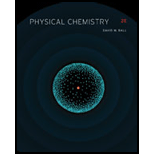
PHYSICAL CHEMISTRY-STUDENT SOLN.MAN.
2nd Edition
ISBN: 9781285074788
Author: Ball
Publisher: CENGAGE L
expand_more
expand_more
format_list_bulleted
Question
Chapter 18, Problem 18.29E
Interpretation Introduction
Interpretation:
The temperature at which the
Concept introduction:
The rotational partition function for the linear molecules is,
Where,
•
•
•
•
•
•
The partition function is a unitless quantity.
Expert Solution & Answer
Want to see the full answer?
Check out a sample textbook solution
Students have asked these similar questions
What is the pH of a 1.0 L buffer made with 0.300 mol of HF (Ka = 6.8 × 10⁻⁴) and 0.200 mol of NaF to which 0.160 mol of NaOH were added?
Determine if the following salt is neutral, acidic or basic. If acidic or basic, write the appropriate equilibrium equation for the acid or base that exists when the salt is dissolved in aqueous solution. If neutral, simply write only NR. Be sure to include the proper phases for all species within the reaction. NaN₃
Can I please get help with this?
Chapter 18 Solutions
PHYSICAL CHEMISTRY-STUDENT SOLN.MAN.
Ch. 18 - Prob. 18.1ECh. 18 - Prob. 18.2ECh. 18 - Prob. 18.3ECh. 18 - Prob. 18.4ECh. 18 - The following are the first four electronic energy...Ch. 18 - Prob. 18.6ECh. 18 - Prob. 18.7ECh. 18 - Prob. 18.8ECh. 18 - Prob. 18.9ECh. 18 - Prob. 18.10E
Ch. 18 - Prob. 18.11ECh. 18 - Prob. 18.12ECh. 18 - Prob. 18.13ECh. 18 - Prob. 18.14ECh. 18 - Prob. 18.15ECh. 18 - Prob. 18.16ECh. 18 - Prob. 18.17ECh. 18 - Prob. 18.18ECh. 18 - Prob. 18.19ECh. 18 - Prob. 18.20ECh. 18 - Prob. 18.21ECh. 18 - Prob. 18.22ECh. 18 - Prob. 18.23ECh. 18 - Prob. 18.24ECh. 18 - Prob. 18.25ECh. 18 - Prob. 18.26ECh. 18 - Prob. 18.27ECh. 18 - Prob. 18.28ECh. 18 - Prob. 18.29ECh. 18 - Prob. 18.30ECh. 18 - Prob. 18.31ECh. 18 - Prob. 18.32ECh. 18 - Prob. 18.33ECh. 18 - What are qnuc and qrot for N2(I=1)? See Table 18.3...Ch. 18 - The rovibrational spectrum of acetylene, HCCH,...Ch. 18 - Prob. 18.36ECh. 18 - Prob. 18.37ECh. 18 - Prob. 18.38ECh. 18 - Prob. 18.39ECh. 18 - Prob. 18.40ECh. 18 - Prob. 18.41ECh. 18 - Prob. 18.42ECh. 18 - Use equation 18.44 to show that pV=NkT.Ch. 18 - Prob. 18.44ECh. 18 - Determine E,H,G, and S for CH4 at standard...Ch. 18 - Prob. 18.48ECh. 18 - Prob. 18.49ECh. 18 - Calculate the heat capacity of NO2 at 298K and...Ch. 18 - Prob. 18.51ECh. 18 - In Chapters 17 and 18 we have derived expressions...Ch. 18 - Prob. 18.55ECh. 18 - Prob. 18.56ECh. 18 - Prob. 18.57ECh. 18 - Prob. 18.58ECh. 18 - Prob. 18.59ECh. 18 - Prob. 18.60E
Knowledge Booster
Learn more about
Need a deep-dive on the concept behind this application? Look no further. Learn more about this topic, chemistry and related others by exploring similar questions and additional content below.Similar questions
- Can I please get help with this?arrow_forwardUse the Henderson-Hasselbalch equation to calculate pH of a buffer containing 0.050M benzoic acidand 0.150M sodium benzoate. The Ka of benzoic acid is 6.5 x 10-5arrow_forwardA. Draw the structure of each of the following alcohols. Then draw and name the product you would expect to produce by the oxidation of each. a. 4-Methyl-2-heptanol b. 3,4-Dimethyl-1-pentanol c. 4-Ethyl-2-heptanol d. 5,7-Dichloro-3-heptanolarrow_forward
- What is the pH of a 1.0 L buffer made with 0.300 mol of HF (Ka = 6.8 × 10⁻⁴) and 0.200 mol of NaF to which 0.160 mol of NaOH were added?arrow_forwardCan I please get help with this.arrow_forwardDetermine if the following salt is neutral, acidic or basic. If acidic or basic, write the appropriate equilibrium equation for the acid or base that exists when the salt is dissolved in aqueous solution. If neutral, simply write only NR. Be sure to include the proper phases for all species within the reaction. N₂H₅ClO₄arrow_forward
arrow_back_ios
SEE MORE QUESTIONS
arrow_forward_ios
Recommended textbooks for you
 Physical ChemistryChemistryISBN:9781133958437Author:Ball, David W. (david Warren), BAER, TomasPublisher:Wadsworth Cengage Learning,
Physical ChemistryChemistryISBN:9781133958437Author:Ball, David W. (david Warren), BAER, TomasPublisher:Wadsworth Cengage Learning, Chemistry: The Molecular ScienceChemistryISBN:9781285199047Author:John W. Moore, Conrad L. StanitskiPublisher:Cengage Learning
Chemistry: The Molecular ScienceChemistryISBN:9781285199047Author:John W. Moore, Conrad L. StanitskiPublisher:Cengage Learning Chemistry: Principles and ReactionsChemistryISBN:9781305079373Author:William L. Masterton, Cecile N. HurleyPublisher:Cengage Learning
Chemistry: Principles and ReactionsChemistryISBN:9781305079373Author:William L. Masterton, Cecile N. HurleyPublisher:Cengage Learning Principles of Modern ChemistryChemistryISBN:9781305079113Author:David W. Oxtoby, H. Pat Gillis, Laurie J. ButlerPublisher:Cengage Learning
Principles of Modern ChemistryChemistryISBN:9781305079113Author:David W. Oxtoby, H. Pat Gillis, Laurie J. ButlerPublisher:Cengage Learning World of Chemistry, 3rd editionChemistryISBN:9781133109655Author:Steven S. Zumdahl, Susan L. Zumdahl, Donald J. DeCostePublisher:Brooks / Cole / Cengage Learning
World of Chemistry, 3rd editionChemistryISBN:9781133109655Author:Steven S. Zumdahl, Susan L. Zumdahl, Donald J. DeCostePublisher:Brooks / Cole / Cengage Learning Chemistry by OpenStax (2015-05-04)ChemistryISBN:9781938168390Author:Klaus Theopold, Richard H Langley, Paul Flowers, William R. Robinson, Mark BlaserPublisher:OpenStax
Chemistry by OpenStax (2015-05-04)ChemistryISBN:9781938168390Author:Klaus Theopold, Richard H Langley, Paul Flowers, William R. Robinson, Mark BlaserPublisher:OpenStax

Physical Chemistry
Chemistry
ISBN:9781133958437
Author:Ball, David W. (david Warren), BAER, Tomas
Publisher:Wadsworth Cengage Learning,

Chemistry: The Molecular Science
Chemistry
ISBN:9781285199047
Author:John W. Moore, Conrad L. Stanitski
Publisher:Cengage Learning

Chemistry: Principles and Reactions
Chemistry
ISBN:9781305079373
Author:William L. Masterton, Cecile N. Hurley
Publisher:Cengage Learning

Principles of Modern Chemistry
Chemistry
ISBN:9781305079113
Author:David W. Oxtoby, H. Pat Gillis, Laurie J. Butler
Publisher:Cengage Learning

World of Chemistry, 3rd edition
Chemistry
ISBN:9781133109655
Author:Steven S. Zumdahl, Susan L. Zumdahl, Donald J. DeCoste
Publisher:Brooks / Cole / Cengage Learning

Chemistry by OpenStax (2015-05-04)
Chemistry
ISBN:9781938168390
Author:Klaus Theopold, Richard H Langley, Paul Flowers, William R. Robinson, Mark Blaser
Publisher:OpenStax
The Laws of Thermodynamics, Entropy, and Gibbs Free Energy; Author: Professor Dave Explains;https://www.youtube.com/watch?v=8N1BxHgsoOw;License: Standard YouTube License, CC-BY